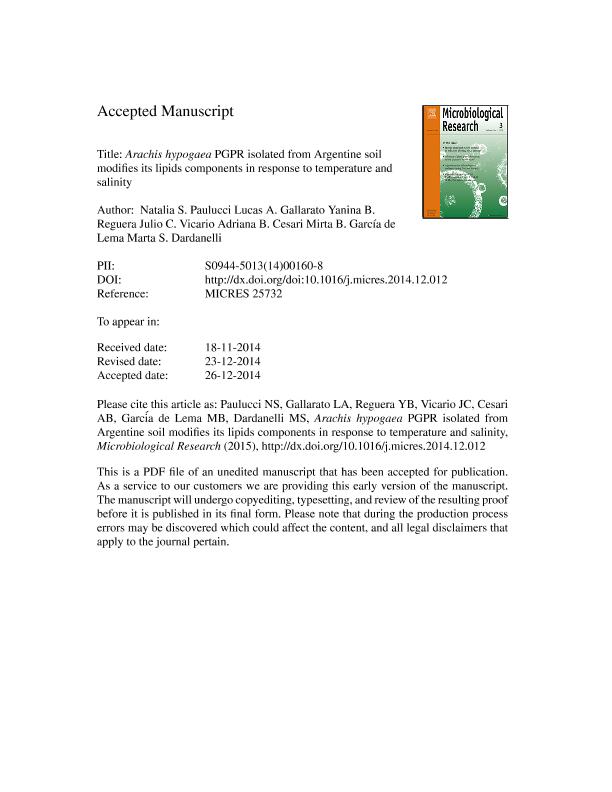Mostrar el registro sencillo del ítem
dc.contributor.author
Paulucci, Natalia Soledad

dc.contributor.author
Gallarato, Lucas Antonio

dc.contributor.author
Reguera, Yanina Belen

dc.contributor.author
Vicario, Julio César

dc.contributor.author
Cesari, Adriana Belen

dc.contributor.author
Garcia, Mirta Beatriz

dc.contributor.author
Dardanelli, Marta Susana

dc.date.available
2018-03-09T17:41:57Z
dc.date.issued
2015-04
dc.identifier.citation
Paulucci, Natalia Soledad; Gallarato, Lucas Antonio; Reguera, Yanina Belen; Vicario, Julio César; Cesari, Adriana Belen; et al.; Arachis hypogaea PGPR isolated from Argentine soil modifies its lipids components in response to temperature and salinity; Elsevier Gmbh; Microbiological Research; 173; 4-2015; 1-9
dc.identifier.issn
0944-5013
dc.identifier.uri
http://hdl.handle.net/11336/38408
dc.description.abstract
The aim of this work was to clarify the mechanism related to plant growth promoting of a bacterial strain (L115) isolated from Arachis hypogaea rhizospheres and the effects of high growth temperature and salinity on phospholipids and fatty acids composition.L115 was isolated from peanut rhizospheres and identified according to the sequence analysis of the 16S rRNA gene. Phenotypic, metabolic and plant growth promoting rhizobacteria (PGPR) characteristics of L115 were tested. Inoculation test in plant growth chamber was performed. In addition, L115 was exposed to a 37. °C and 300. mM NaCl and phospholipids and fatty acid composition were evaluated.L115 strain was identified as Ochrobactrum intermedium and was able to increase the peanut shoot and root length as well as dry weight, indicating a PGPR role by being able to produce indole acetic acid and siderophores and present ACC deaminase activity. In addition, L115 showed tolerance to both high growth temperature and 300. mM NaCl. The most striking change was a decreased percentage of 18:1 fatty acid and an increase in 16:0 and 18:0 fatty acids, under high growth temperature or a combination of increased temperature and salinity. The most important change in phospholipid levels was an increase in phosphatidylcholine biosynthesis in all growth conditions.L115 can promote the growth of peanut and can tolerate high growth temperature and salinity modifying the fatty acid unsaturation degree and increasing phosphatidylcholine levels.This work is the first to report the importance of the genus Ochrobactrum as PGPR on peanut growth as well as on the metabolic behaviour against abiotic stresses that occur in soil. This knowledge will be useful for developing strategies to improve the growth of this bacterium under stress and to enhance its bioprocess for the production of inoculants.
dc.format
application/pdf
dc.language.iso
eng
dc.publisher
Elsevier Gmbh

dc.rights
info:eu-repo/semantics/openAccess
dc.rights.uri
https://creativecommons.org/licenses/by-nc-nd/2.5/ar/
dc.subject
Fatty Acid
dc.subject
Isolated Rhizospheric Bacteria
dc.subject
Pgpr
dc.subject
Phospholipid
dc.subject
Stress
dc.subject.classification
Otras Ciencias Biológicas

dc.subject.classification
Ciencias Biológicas

dc.subject.classification
CIENCIAS NATURALES Y EXACTAS

dc.title
Arachis hypogaea PGPR isolated from Argentine soil modifies its lipids components in response to temperature and salinity
dc.type
info:eu-repo/semantics/article
dc.type
info:ar-repo/semantics/artículo
dc.type
info:eu-repo/semantics/publishedVersion
dc.date.updated
2018-03-02T14:00:28Z
dc.journal.volume
173
dc.journal.pagination
1-9
dc.journal.pais
Alemania

dc.journal.ciudad
Weinheim
dc.description.fil
Fil: Paulucci, Natalia Soledad. Universidad Nacional de Río Cuarto. Facultad de Ciencias Exactas, Fisicoquímicas y Naturales. Departamento de Biología Molecular. Sección Química Biológica; Argentina. Consejo Nacional de Investigaciones Científicas y Técnicas; Argentina
dc.description.fil
Fil: Gallarato, Lucas Antonio. Universidad Nacional de Río Cuarto. Facultad de Ciencias Exactas, Fisicoquímicas y Naturales. Departamento de Biología Molecular. Sección Química Biológica; Argentina. Consejo Nacional de Investigaciones Científicas y Técnicas; Argentina
dc.description.fil
Fil: Reguera, Yanina Belen. Universidad Nacional de Río Cuarto. Facultad de Ciencias Exactas, Fisicoquímicas y Naturales. Departamento de Biología Molecular. Sección Química Biológica; Argentina. Consejo Nacional de Investigaciones Científicas y Técnicas; Argentina
dc.description.fil
Fil: Vicario, Julio César. Universidad Nacional de Río Cuarto. Facultad de Ciencias Exactas, Fisicoquímicas y Naturales. Departamento de Biología Molecular. Sección Química Biológica; Argentina. Consejo Nacional de Investigaciones Científicas y Técnicas; Argentina
dc.description.fil
Fil: Cesari, Adriana Belen. Universidad Nacional de Río Cuarto. Facultad de Ciencias Exactas, Fisicoquímicas y Naturales. Departamento de Biología Molecular. Sección Química Biológica; Argentina. Consejo Nacional de Investigaciones Científicas y Técnicas; Argentina
dc.description.fil
Fil: Garcia, Mirta Beatriz. Universidad Nacional de Río Cuarto. Facultad de Ciencias Exactas, Fisicoquímicas y Naturales. Departamento de Biología Molecular. Sección Química Biológica; Argentina. Consejo Nacional de Investigaciones Científicas y Técnicas; Argentina
dc.description.fil
Fil: Dardanelli, Marta Susana. Universidad Nacional de Río Cuarto. Facultad de Ciencias Exactas, Fisicoquímicas y Naturales. Departamento de Biología Molecular. Sección Química Biológica; Argentina. Consejo Nacional de Investigaciones Científicas y Técnicas; Argentina
dc.journal.title
Microbiological Research

dc.relation.alternativeid
info:eu-repo/semantics/altIdentifier/doi/http://dx.doi.org/10.1016/j.micres.2014.12.012
dc.relation.alternativeid
info:eu-repo/semantics/altIdentifier/url/https://www.sciencedirect.com/science/article/pii/S0944501314001608
Archivos asociados
